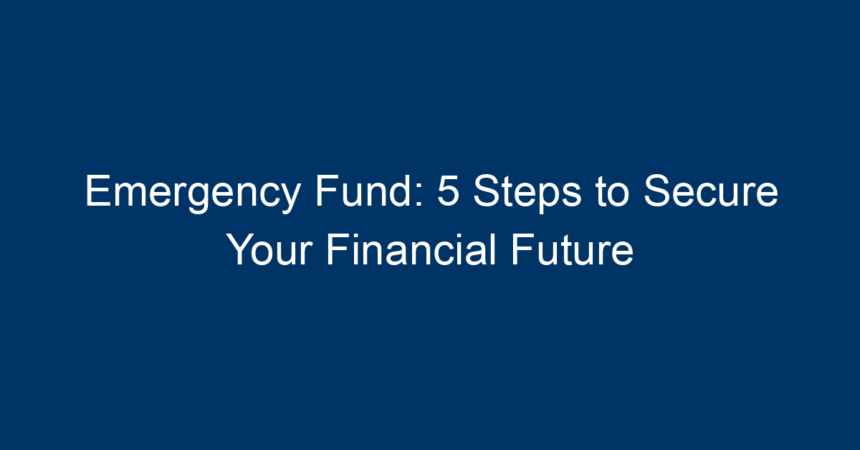In an unpredictable world, having an emergency fund is crucial for financial stability. Whether it’s an unexpected medical bill, a sudden job loss, or urgent home repairs, an emergency fund provides a financial cushion that can keep you afloat during crises. But what exactly constitutes an emergency fund, and how can you build one effectively? In this article, we will explore five essential steps to secure your financial future through an emergency fund, providing you with actionable insights to get started today.
What Is an Emergency Fund?
An emergency fund is a dedicated savings account set aside for unplanned expenses or financial emergencies. Think of it as your safety net, designed to help you navigate unforeseen circumstances without derailing your long-term financial goals. Experts typically recommend saving three to six months’ worth of living expenses to cover basic needs, ensuring you have ample resources in times of need.
Step 1: Assess Your Financial Situation
Before diving into building your emergency fund, it’s essential to assess your current financial situation.
Analyze Your Income and Expenses
Start by documenting your total monthly income and expenses. This includes fixed costs like rent or mortgage payments, utilities, groceries, and other essential expenses. Understanding where your money is going can help you identify areas where you can cut back, making it easier to allocate funds to your emergency fund.
Set a Savings Goal
Based on your assessment, set a realistic savings goal. For most people, this means determining how much you will need for three to six months of living expenses. For example, if your monthly living expenses total $3,000, aim for an emergency fund of $9,000 to $18,000. Having a clear target will make your savings journey more manageable.
Step 2: Create a Budget That Includes Savings
Having a budget is essential for successful money management. But to ensure you’re building your emergency fund effectively, incorporate savings into your budgeting plan.
Allocate a Portion for Savings
Dedicate a portion of your monthly income specifically for your emergency fund. This might mean cutting non-essential expenses or finding ways to increase your income through side gigs or freelance work. The key is to treat your emergency fund contribution like any other fixed expense.
Use the 50/30/20 Rule
Consider using the 50/30/20 budgeting rule, which divides your after-tax income into three categories:
- 50% for needs (essential expenses)
- 30% for wants (discretionary spending)
- 20% for savings (including your emergency fund)
This balanced approach ensures that you’re not only preparing for emergencies but also enjoying your life and planning for the future.
Step 3: Choose the Right Account for Your Emergency Fund
Where you store your emergency fund matters. Choosing the right account ensures that your savings are secure and accessible when needed.
High-Yield Savings Accounts
Consider opening a high-yield savings account specifically for your emergency fund. These accounts typically offer higher interest rates than traditional savings accounts, allowing your money to grow over time. This is particularly important because inflation can erode your purchasing power if your money isn’t actively growing.
Features to Look For
When selecting an account for your emergency fund, look for:
- Low or no fees
- No minimum balance requirements
- Easy access (online banking capabilities and ATM access)
- Depository insurance, like FDIC insurance in the United States
By opting for a high-yield savings account, you’ll earn interest while keeping your funds safe and accessible.
Step 4: Automate Your Savings
Once you’ve established your budget and chosen the right account, the next step is to automate your savings. Automation takes the effort out of saving, making it easier to reach your emergency fund goals.
Set Up Automatic Transfers
Schedule automatic transfers from your checking account to your emergency fund on payday. This ensures that you’re consistently contributing to your savings without needing to think about it. Set the transfer amount based on your budget, and adjust it as your financial situation evolves.
Track Your Progress
Regularly monitor the balance of your emergency fund. Many online banking platforms provide tools to help you visualize your savings growth. Seeing your progress can motivate you to continue building your fund and remind you of the security it provides.
Step 5: Review and Adjust Your Emergency Fund Regularly
As circumstances change, so should your emergency fund. Regular reviews ensure that your savings align with your current financial needs.
Reassess Your Savings Goal
Life changes — new jobs, moves, or additional family members can significantly impact your expenses. Periodically reassess your financial situation and adjust your savings goal accordingly. Increasing your goal as your expenses rise ensures that you’re always prepared for whatever life throws your way.
Maintain Your Fund
It’s important to remember that your emergency fund should always remain intact. In case you need to tap into your savings for an unforeseen expense, commit to replenishing the fund immediately. This way, you ensure you’re never without financial security during hard times.
Conclusion: The Path to Financial Security
Building an emergency fund is not just about saving; it’s about creating a resilient financial foundation for your future. By following these five steps—assessing your financial situation, creating a budget, choosing the right savings account, automating your savings, and regularly reviewing your fund—you can secure the peace of mind that comes with knowing you’re prepared for the unexpected.
Taking the first step might feel daunting, but remember that progress is made one dollar at a time. Start small, stay consistent, and your emergency fund will grow, providing you with the financial freedom to navigate life’s uncertainties. Don’t wait for a financial emergency to happen; take action today to protect your future.
With dedication and smart management, your emergency fund can be the difference between a temporary setback and a full financial crisis. Start building yours now and secure your financial future!
This article provides a comprehensive guide to creating an emergency fund, reinforcing the importance of financial preparation in everyday life. Feel free to share it or utilize parts of it to enhance your knowledge or help others on their financial journey!




